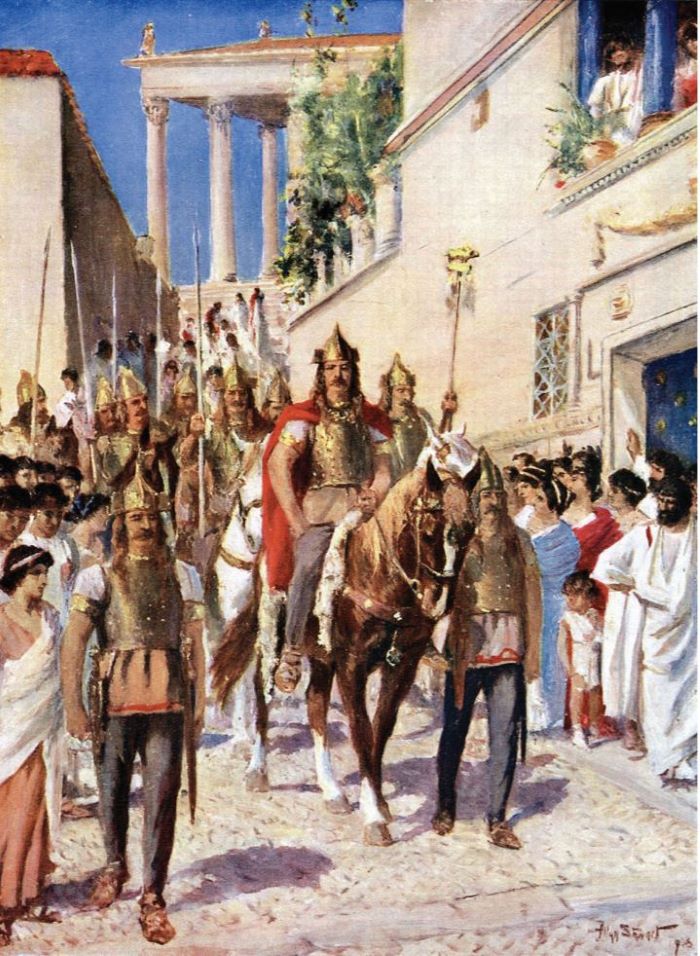Around 410 the Romano-British expelled the. 383 is the last date for any evidence of a Roman presence in the north and west of Britain perhaps excepting troop assignments at the tower on Holyhead Mountain in Anglesey and at western coastal posts such as Lancaster.

Read The Fall Of Rome Article Khan Academy
It began in earnest in AD 43 under Emperor Claudius and was largely completed in the southern half of Britain by 87 when the Stanegate was established.

. The withdrawal of Roman armies from Britain enabled A Celtic Britons to overrun the island. 0 votes and 0 comments so far on Reddit. The withdrawal of Roman armies from Britain enabled.
In fact the emperor had lost control several years. In addition provincial barbarians led by their own kings and chieftains filled the ranks. Angles and Saxons Germanic tribes from Denmark and Germany to invade and to establish new kingdoms on the isle.
Within 40 to 50 years from the time of the departure of the Romans to the arrival in 597 of Augustine of Canterbury on a mission to convert the Anglo-Saxons and for a period thereafter it is believed. A New History by Guy de la Bedoyere Thames and Hudson 2006 Hadrians Wall by David Breeze. Angles and Saxons Germanic tribes from Denmark and Germany to invaded and to establish new kingdoms on the isle.
The Roman Army in Britain by Guy de la Bedoyere Tempus 2003 Roman Britain. Conquest of the far north and Scotland took longer with fluctuating success. The numbers for limitanei in north Britain are subjective - anything from Simon James 4800 to Hugh Eltons 19240.
Eagles over Britannia. AD 48 The Romans have now. The withdrawal of Roman armies from Britain enabled Angles and Saxons Germanic tribes from Denmark and Germany to invade and to establish new kingdoms on the isle.
In the latter 4th Century more and more field army troops were being taken from Britain to the continent by the various. The troop strength in the north was comprised of limitanei. Roman withdrawal from Britain.
That decline created a twilight period in which the trappings of Roman civilisation and culture gradually faded out of use and out of living memory. Attack from the North the Picts attack from the West the Irish - for example the Scots tribe who later conquered much of what was to become Scotland from the Picts and MOST IMPORTANTLY from the east. The end of Roman rule in Britain was the transition from Roman Britain to post-Roman BritainRoman rule ended in different parts of Britain at different times and under different circumstances.
To prevent injuries leading to disastrous blood feuds the Germanic tribes devised the wergeld. Part of a series on the. Leaving a major political body is nothing new for mainland Britain.
Thats when the experience of being part of the Roman Empire finished in Britain. The decline of Roman control over Britain was a drawn-out affair which took perhaps a quarter of a century to complete. Prehistoric Britain and Ireland.
Troops had to be brought from the west which included those in Britain. In 383 the usurper Magnus Maximus withdrew troops from northern and western Britain probably leaving local warlords in charge. Angles and Saxons Germanic tribes from Denmark and Germany to invade and to establish new kingdoms on the isle.
The withdrawal of Roman armies from Britain enabled. With the withdrawal of imperial authority Roman Britain did not magically cease to exist. The Roman army was generally recruited in.
I personally favor an introduction of some foederati from after the Great Conspiracy. Roman withdrawal from Britain. In 410 Roman legions withdrew from the province of BritanniaWith the departure of the last legions from Britain and the end of Roman rule literacy gradually left England.
In 409AD more than 350 years after the Roman conquest of 43AD the island slipped from the control of the Roman Empire. From most indications virtually the entire garrison ie. The withdrawal of Roman armies from Britain enabled.
The Roman conquest of Britain refers to the conquest of the island of Britain by occupying Roman forces. The seeds were sown in the fourth century decline. D local Roman elites to rebuild English Latin culture.
B Angles and Saxons Germanic tribes from Denmark and Germany to invade and to establish new kingdoms on the isle. The greatest difference between Irish Christianity and Roman Christianity was in. AD 43 The Roman Emperor Claudius orders four legions to conquer Britain.
27 BC Augustus becomes the first Roman emperor. Answer 1 of 22. AD 43 August The Romans capture the capital of the Catuvellauni tribe Colchester Essex.
C the rise of medieval Scottish culture. Demonstrates how the virtues of duty and simplicity in Romes leaders enabled Rome to survive in difficult times. Augustine did all of the following except.
The Province of Britain was left open to attack when the Roman Army left. History of the British Isles. History of the British Isles.
The ending of the Roman occupation was Britains first Brexit which probably happened about AD 408-409. Defeating Muslim armies in 732. E someone later known as King Arthur to drive the Vikings.
Posted on February 10 2021. Irish church organization giving Irish abbots more power. AD 44 June The Romans capture the hills forts of Dorset including Maiden Castle.
He killed the Western Roman Emperor Gratian and ruled Gaul and Britain as Caesar ie as a sub-emperor under Theodosius I. In AD 378 the Romans suffered a catastrophic defeat at Adrianople where two-thirds of their eastern army was destroyed. 02 Aug 2019.
Translate Scripture into the Latin Vulgate.
Why Did The Romans Leave Britain Quora

5 Battles That Made The Late Roman Empire

The Age Of Arthur Part One Hadrians Wall Roman Britain Ancient Rome

Barbarians At The Open Gates And The Missing Roman Army Exploring Gaps In The Conventional Explanation
0 Comments